Challenges Associated with Implementing 5G in Manufacturing
Abstract
:1. Introduction
- eMBB (Enhanced Mobile Broadband)
- URLLC (Ultra-Reliable Low Latency Communications)
- mMTC (Massive Machine-Type Communications)
1.1. Enhanced Mobile Broadband (eMBB)
- Traffic capacity of up to 10 Mbps per sq. metre in hotspot areas.
- Data transfer rates the user experiences of up to 1 Gbps with peak data rates of transfer in the tens of Gbps and a capacity of maximum traffic volume of at least 1 Tbps per sq. kilometre.
- Latency as low as 1ms for user experience levels of data exchange.
- Connection density of up to one million connections per sq. kilometre.
- High mobility, facilitating connectivity up to 500 km/h in high-speed trains and up to 1000 km/h in aeroplanes, with enhanced user experience.
1.2. Ultra-Reliable and Low-Latency Communications (URLLC)
1.3. Massive Machine-Type Communications (mMTC)
2. The Potential of 5G in Manufacturing
- λ (Lambda) = Wavelength in meters
- c = Speed of Light (299,792,458 m/s)
- f = Frequency (MHz)
How 5G Will Impact Manufacturing
- Ability to remotely operate equipment e.g., production line robotics on the factory floor. Typical applications being welding, painting and assembly.
- Remote control of supply chain equipment e.g., operator can remote control equipment such as untethered robots, typical applications include, autonomous ground vehicles (AGVs) or forklifts.
- Remote monitoring of equipment e.g., the transmission of diagnostics information, so service technicians arrive prepared for successful repairs and updates when needed.
- Machine to machine communication: closed-loop communications between machines to optimize manufacturing processes.
- Intra- and inter-enterprise communication: for monitoring of assets distributed in broader geographical areas across the value chain.
- Augmented reality support in design, maintenance and repair: use of augmented reality to aid in the execution of procedural tasks in the design, maintenance and repair domain (through simulations).
- Cost: the manufacturing industry has high-cost reduction requirements and will only implement new applications if these have been proven to reduce costs ultimately.
- Safety: hundreds of connected automated devices on a factory floor can create a hazardous environment for humans.
- Deployment knowledge: many small and medium enterprises (SMEs) do not have the capacity to resource the learning requirements or the technical ability to capitalise on the potentials of 5G.
- RF interference: several objects on the factory floor are already using radio communications.
3. Use Cases of 5G in Manufacturing
3.1. Supply Chain Unification
3.2. Artificial Intelligence (AI) and Fast Decision Making
3.3. Cloud Control of Machines
3.4. Expanded Reality
4. Infrastructure Requirements for 5G
- Spectrum adoption;
- Fiber rollout internally (10 Gb minimally);
- High-speed switches and routers;
- On-site computing;
- High-speed uplink to cloud computing facilities;
- Deploying edge-connecting devices.
4.1. 5G in a Heterogeneous Network Infrastructure
4.2. Fog and Edge Computing
4.2.1. Edge Computing
4.2.2. Multi-Access Edge Computing (MEC)
5. The Wireless Spectrum and 5G
6. Private 5G Networks
- Connect to a public 5G network.
- Build and use a private 5G network.
Benefits of Private 5G Networks
7. Security in the Wireless Factory of the Future
- Denial-of-service (DoS) and distributed denial-of-service (DDoS) attacks on production systems.
- Man-in-the-middle attack for production data theft due to gaps in the IT structure of the newly adapted manufacturing processes.
- Anomalies based on human behaviour and errors.
- Critical system access to third-party contractors.
- Legacy devices with limited or no security services such as programmable logic controllers (PLCs), remote terminal units (RTUs), supervisory control and data acquisition (SCADA) servers, integrated with fully accessible and network-enabled IoT devices.
- Lack of adequate visibility and cyber-resilient systems. Traditionally OT systems have achieved security by obscurity and this is no longer a guarantee of protection with the advent of wireless connectivity and massive machine-type communication (mMTC).
8. Standards and Industry Associations
- Industrial Internet Consortium (IIC), https://www.iiconsortium.org/index.htm.
- The 3rd Generation Partnership Project (3GPP), https://www.3gpp.org/.
- The 5G Alliance for Connected Industries and Automation (5G-ACIA), https://www.5gacia.org/about-5g-acia/.
- EU 5GPPP, https://5g-ppp.eu/.
- Co-existence of different wireless protocols and systems;
- Co-existence of different wired protocols;
- Interoperability between wired and wireless communication systems;
- Seamless engineering taking into account collected real-life data;
- Missing capabilities for plug-and-produce integration of sensors, machinery and people;
- Missing capabilities for cost-effective network and service management by factory operator;
- Managing workflows and data interaction patterns between an increasing number of sensors, machines, robots, wearables, etc.;
- Allocating the proper computing resources in the cloud, on the edge or at sensor levels to ensure compliance with application-level service agreements;
- Leveraging machine-learning and data analytics capabilities distributed in the network, to a multitude of vendor-specific platforms, contributing to a unified, intelligent data intelligence platform;
- Managing and optimizing the wireless network topology and performance, according to real-time changing networking conditions.
Future Improvements of 5G towards 6G
9. Conclusions
Funding
Acknowledgments
Conflicts of Interest
References
- Mao, Y.; You, C.; Zhang, J.; Huang, K.; Letaief, K.B. A Survey on Mobile Edge Computing: The Communication Perspective. IEEE Commun. Surv. Tutor. 2017, 19, 2322–2358. [Google Scholar] [CrossRef] [Green Version]
- McCann, J.; Quinn, L.; McGrath, S.; O’Connell, E. Towards the Distributed Edge–An IoT Review. In Proceedings of the 2018 12th International Conference on Sensing Technology (ICST), Limerick, Ireland, 3–6 December 2018; pp. 263–268. [Google Scholar]
- Bockelmann, C.; Pratas, N.K.; Wunder, G.; Saur, S.; Navarro, M.; Gregoratti, D.; Vivier, G.; De Carvalho, E.; Ji, Y.; Stefanovic, C.; et al. Towards Massive Connectivity Support for Scalable mMTC Communications in 5G Networks. IEEE Access 2018, 6, 28969–28992. [Google Scholar] [CrossRef]
- Popovski, P.; Trillingsgaard, K.F.; Simeone, O.; Durisi, G. 5G Wireless Network Slicing for eMBB, URLLC, and mMTC: A Communication-Theoretic View. IEEE Access 2018, 6, 55765–55779. [Google Scholar] [CrossRef]
- Siddiqi, M.; Yu, H.; Joung, J. 5G Ultra-Reliable Low-Latency Communication Implementation Challenges and Operational Issues with IoT Devices. Electronics 2019, 8, 981. [Google Scholar] [CrossRef] [Green Version]
- Gidlund, M.; Lennvall, T.; Akerberg, J. Will 5G become yet another wireless technology for industrial automation? In Proceedings of the 2017 IEEE International Conference on Industrial Technology (ICIT), Toronto, ON, Canada, 22–25 March 2017; pp. 1319–1324. [Google Scholar]
- Orlosky, J.; Kiyokawa, K.; Takemura, H. Virtual and Augmented Reality on the 5G Highway. J. Inf. Process. 2017, 25, 133–141. [Google Scholar] [CrossRef] [Green Version]
- GSMA Intelligence. Understanding 5G: Perspectives on Future Technological Advancements in Mobile. White Paper. 2014, pp. 1–26. Available online: https://www.gsma.com/futurenetworks/wp-content/uploads/2015/01/2014-12-08-c88a32b3c59a11944a9c4e544fee7770.pdf (accessed on 10 June 2020).
- Cheng, J.; Chen, W.; Tao, F.; Lin, C.-L.; Da Xu, L. Industrial IoT in 5G environment towards smart manufacturing. J. Ind. Inf. Integr. 2018, 10, 10–19. [Google Scholar] [CrossRef]
- Mudrakola, S. Private 5G Networks. 2019. Available online: http://techgenix.com/private-5g-networks/ (accessed on 10 June 2020).
- Onoe, S. Plenary speaker 1. In Proceedings of the 2017 IEEE Radio Frequency Integrated Circuits Symposium (RFIC), Honolulu, HI, USA, 4–6 June 2017; p. 1. [Google Scholar] [CrossRef]
- Atanasovski, V.; Leon-Garcia, A. Future Access Enablers for Ubiquitous and Intelligent Infrastructures; Springer: Berlin, Germany, 2015. [Google Scholar]
- Baharom, B.; Ali, M.T. Multiple-element PIFA MIMO antenna system design for future 5G wireless communication applications. In Proceedings of the 2017 IEEE Asia Pacific Microwave Conference (APMC), Kuala Lumpur, Malaysia, 13–16 November 2017; pp. 743–746. [Google Scholar]
- Arthur D. Little for Vodafone Group Plc. “Creating a Gigabit Society”. Available online: https://www.vodafone.com/content/dam/vodcom/files/public-policy/Vodafone_Group_Call_for_the_Gigabit_SocietyFV.pdf (accessed on 10 June 2020).
- Rampa, V.; Savazzi, S.; Malandrino, F. Opportunistic sensing in beyond-5G networks: The opportunities of transformative computing. In 5G Italy Book 2019: A Multiperspective View of 5G; CNIT: Parma, Italy, 2019; pp. 461–476. ISBN 9788832170030. [Google Scholar]
- Wdowik, R.; Ratnayake, R.C. Collaborative Technological Process Planning with 5G Mobile Networks and Digital Tools: Manufacturing Environments’ Perspective. In Proceedings of the 2019 IEEE International Conference on Industrial Engineering and Engineering Management (IEEM), Macau, China, 15–18 December 2019; pp. 349–353. [Google Scholar]
- Plant Automation Technology Impact of 5G in Manufacturing Industry. Available online: https://www.plantautomation-technology.com/articles/impact-of-5g-in-manufacturing-industry (accessed on 10 June 2020).
- Elayoubi, S.E.; Fallgren, M.; Spapis, P.; Zimmermann, G.; Martín-Sacristán, D.; Yang, C.; Jeux, S.; Agyapong, P.; Campoy, L.; Qi, Y.; et al. 5G service requirements and operational use cases: Analysis and METIS II vision. In Proceedings of the 2016 European Conference on Networks and Communications (EuCNC), Athens, Greece, 27–30 June 2016; pp. 158–162. [Google Scholar]
- Singh, S.; Singh, P. Key concepts and network architecture for 5G mobile technology. Int. J. Sci. Res. Eng. Technol. (IJSRET) 2012, 1, 165–170. [Google Scholar]
- Barakabitze, A.A.; Ahmad, A.; Mijumbi, R.; Hines, A. 5G network slicing using SDN and NFV: A survey of taxonomy, architectures and future challenges. Comput. Netw. 2020, 167, 106984. [Google Scholar] [CrossRef]
- Chen, B.; Wan, J.; Shu, L.; Li, P.; Mukherjee, M.; Yin, B. Smart Factory of Industry 4.0: Key Technologies, Application Case, and Challenges. IEEE Access 2018, 6, 6505–6519. [Google Scholar] [CrossRef]
- Ludwig, S.; Karrenbauer, M.; Fellan, A.; Schotten, H.; Buhr, H.; Seetaraman, S.; Niebert, N.; Bernardy, A.; Seelmann, V.; Stich, V.; et al. A5G architecture for the factory of the future. In Proceedings of the 2018 IEEE 23rd international conference on emerging technologies and factory automation (ETFA), Torino, Italy, 4–7 September 2018; Volume 1, pp. 1409–1416. [Google Scholar]
- Shi, W.; Cao, J.; Zhang, Q.; Li, Y.; Xu, L. Edge Computing: Vision and Challenges. IEEE Internet Things J. 2016, 3, 637–646. [Google Scholar] [CrossRef]
- Gubbi, J.; Buyya, R.; Marusic, S.; Palaniswami, M. Internet of Things (IoT): A vision, architectural elements, and future directions. Futur. Gener. Comput. Syst. 2013, 29, 1645–1660. [Google Scholar] [CrossRef] [Green Version]
- Vermesan, O.; Bröring, A.; Tragos, E.; Serrano, M.; Bacciu, D.; Chessa, S.; Gallicchio, C.; Micheli, A.; Dragone, M.; Saffiotti, A.; et al. Internet of robotic things: Converging sensing/actuating, hypoconnectivity, artificial intelligence and IoT Platforms. In Cognitive Hyperconnected Digital Transformation: Internet of Things Intelligence Evolution; River Publishers: Gistrup, Denmark, 2017; pp. 97–155. [Google Scholar]
- Gremban, K. Editorial and Introduction to the Issue: Risk and Rewards of the Internet of Things. IEEE Internet Things Mag. 2018, 1, 2–3. [Google Scholar] [CrossRef]
- Hu, Y.C.; Patel, M.; Sabella, D.; Sprecher, N.; Young, V. Mobile edge computing—A key technology towards 5G. ETSI White Paper 2015, 11, 1–16. [Google Scholar]
- Tran, T.X.; Hajisami, A.; Pandey, P.; Pompili, D. Collaborative Mobile Edge Computing in 5G Networks: New Paradigms, Scenarios, and Challenges. IEEE Commun. Mag. 2017, 55, 54–61. [Google Scholar] [CrossRef] [Green Version]
- Tran, T.X.; Hosseini, M.-P.; Pompili, D. Mobile edge computing: Recent efforts and five key research directions. IEEE COMSOC MMTC Commun-Frontiers 2017, 12, 29–34. [Google Scholar]
- Wu, Q.; Ding, G.; Du, Z.; Sun, Y.; Jo, M.; Vasilakos, A.V. A Cloud-Based Architecture for the Internet of Spectrum Devices Over Future Wireless Networks. IEEE Access 2016, 4, 2854–2862. [Google Scholar] [CrossRef]
- Wu, C.; Wang, Y.; Yin, Z. Energy-efficiency opportunistic spectrum allocation in cognitive wireless sensor network. EURASIP J. Wirel. Commun. Netw. 2018, 2018, 1–14. [Google Scholar] [CrossRef] [Green Version]
- Wieruch, D.; Holfeld, B.; Wirth, T. Wireless Factory Automation: Radio Channel Evolution in Repeated Manufacturing Processes. In Proceedings of the WSA 2016, 20th International ITG Workshop on Smart Antennas, VDE, Munich, Germany, 9–11 March 2016; pp. 1–4. [Google Scholar]
- Montgomery, K.; Candell, R.; Liu, Y.; Hany, M. Wireless User Requirements for the Factory Workcell. Available online: https://tsapps.nist.gov/publication/get_pdf.cfm?pub_id=928517 (accessed on 10 June 2020).
- Mochón, M.A.; Saez, Y. A review of radio spectrum combinatorial clock auctions. Telecommun. Policy 2017, 41, 303–324. [Google Scholar] [CrossRef]
- Kalliovaara, J.; Ekman, R.; Paavola, J.; Jokela, T.; Hallio, J.; Auranen, J.; Talmola, P.; Kokkinen, H. Designing a testbed infrastructure for experimental validation and trialing of 5G vertical applications. In Proceedings of the International Conference on Cognitive Radio Oriented Wireless Networks, Lisbon, Portugal, 20–21 September 2017; pp. 247–263. [Google Scholar] [CrossRef] [Green Version]
- Hu, F.; Chen, B.; Zhu, K. Full Spectrum Sharing in Cognitive Radio Networks Toward 5G: A Survey. IEEE Access 2018, 6, 15754–15776. [Google Scholar] [CrossRef]
- Ejaz, W.; Ibnkahla, M. Multiband Spectrum Sensing and Resource Allocation for IoT in Cognitive 5G Networks. IEEE Internet Things J. 2017, 5, 150–163. [Google Scholar] [CrossRef]
- Doyle, L.; Kibilda, J.; Forde, T.K.; DaSilva, L. Spectrum Without Bounds, Networks Without Borders. Proc. IEEE 2014, 102, 351–365. [Google Scholar] [CrossRef]
- Dong, X.; Cheng, L.; Zheng, G.; Wang, T. Network access and spectrum allocation in next-generation multi-heterogeneous networks. Int. J. Distrib. Sens. Netw. 2019, 15, 1550147719866140. [Google Scholar] [CrossRef] [Green Version]
- 802.11-2016-IEEE Standard for Information Technology--Telecommunications and Information Exchange between Systems Local and Metropolitan Area Networks--Specific Requirements-Part 11: Wireless LAN Medium Access Control (MAC) and Physical Layer (PHY) Specifications; IEEE: Piscataway, NJ, USA, 2016.
- Bhattarai, S.; Park, J.-M.; Gao, B.; Bian, K.; Lehr, W. An Overview of Dynamic Spectrum Sharing: Ongoing Initiatives, Challenges, and a Roadmap for Future Research. IEEE Trans. Cogn. Commun. Netw. 2016, 2, 110–128. [Google Scholar] [CrossRef]
- Ashraf, S.A.; Aktas, I.; Eriksson, E.; Helmersson, K.W.; Ansari, J. Ultra-reliable and low-latency communication for wireless factory automation: From LTE to 5G. In Proceedings of the 2016 IEEE 21st International Conference on Emerging Technologies and Factory Automation (ETFA), Berlin, Germany, 6–9 September 2016; pp. 1–8. [Google Scholar] [CrossRef]
- Akyildiz, I.F.; Lee, W.-Y.; Vuran, M.C.; Mohanty, S. NeXt generation/dynamic spectrum access/cognitive radio wireless networks: A survey. Comput. Netw. 2006, 50, 2127–2159. [Google Scholar] [CrossRef]
- Mahmud, R.; Kotagiri, R.; Buyya, R. Fog Computing: A Taxonomy, Survey and Future Directions. In Internet of Everything; Springer: Berlin, Germany, 2018; pp. 103–130. [Google Scholar]
- Li, J.; Li, Y.K.; Chen, X.; Lee, P.P.; Lou, W. A Hybrid Cloud Approach for Secure Authorized Deduplication. IEEE Trans. Parallel Distrib. Syst. 2014, 26, 1206–1216. [Google Scholar] [CrossRef]
- Chien, H.-T.; Lin, Y.-D.; Lai, C.-L.; Wang, C.-T. End-to-End Slicing as a Service with Computing and Communication Resource Allocation for Multi-Tenant 5G Systems. IEEE Wirel. Commun. 2019, 26, 104–112. [Google Scholar] [CrossRef]
- Coll-Perales, B.; Gozalvez, J.; Maestre, J.L. 5G and Beyond: Smart Devices as Part of the Network Fabric. IEEE Netw. 2019, 33, 170–177. [Google Scholar] [CrossRef] [Green Version]
- Gringoli, F.; Patras, P.; Donato, C.; Serrano, P.; Grunenberger, Y. Performance Assessment of Open Software Platforms for 5G Prototyping. IEEE Wirel. Commun. 2018, 25, 10–15. [Google Scholar] [CrossRef] [Green Version]
- Di Mauro, M.; Liotta, A. An experimental evaluation and characterization of VoIP over an LTE-A network. IEEE Trans. Netw. Serv. Manag. 2020. [Google Scholar] [CrossRef]
- O’Connell, E.; Healy, M.; O’Keeffe, S.; Newe, T.; Lewis, E. Development of a discriminating fibre optic sensing array for wireless real time analysis of the maritime environment. In Proceedings of the OFS2012 22nd International Conference on Optical Fiber Sensors, Beijing, China, 14–19 October 2012. [Google Scholar] [CrossRef]
- Ruili, J.; Haocong, W.; Han, W.; O’Connell, E.; McGrath, S. Smart Parking System Using Image Processing and Artificial Intelligence. In Proceedings of the 2018 12th International Conference on Sensing Technology (ICST), Limerick, Ireland, 3–6 December 2018; pp. 232–235. [Google Scholar]
- Haerick, W.; Gupta, M. 5G and the Factories of the Future. 5G-PPP White Paper. 2015. Available online: https://5g-ppp.eu/wp-content/uploads/2014/02/5G-PPP-White-Paper-on-Factories-of-the-Future-Vertical-Sector.pdf (accessed on 10 June 2020).
- ENISA draws Threat Landscape of 5G Networks. Available online: https://www.enisa.europa.eu/news/enisa-news/enisa-draws-threat-landscape-of-5g-networks. (accessed on 10 June 2020).
- Vidal, J.M.; Monge, M.A.S. Framework for Anticipatory Self-Protective 5G Environments. In Proceedings of the 14th International Conference on Availability, Reliability and Security, Canterbury, UK, 26–29 August 2019; pp. 1–9. [Google Scholar]

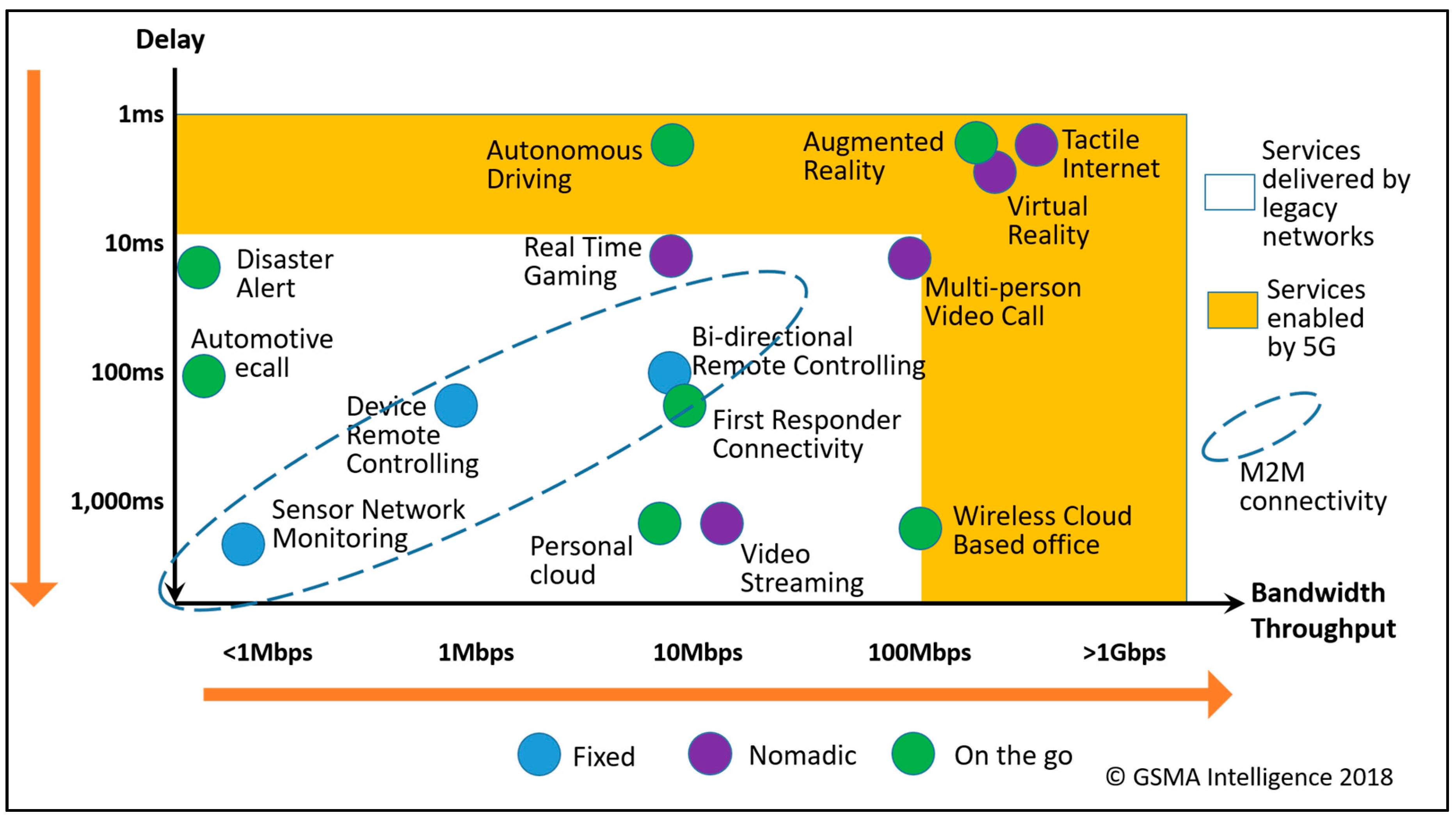
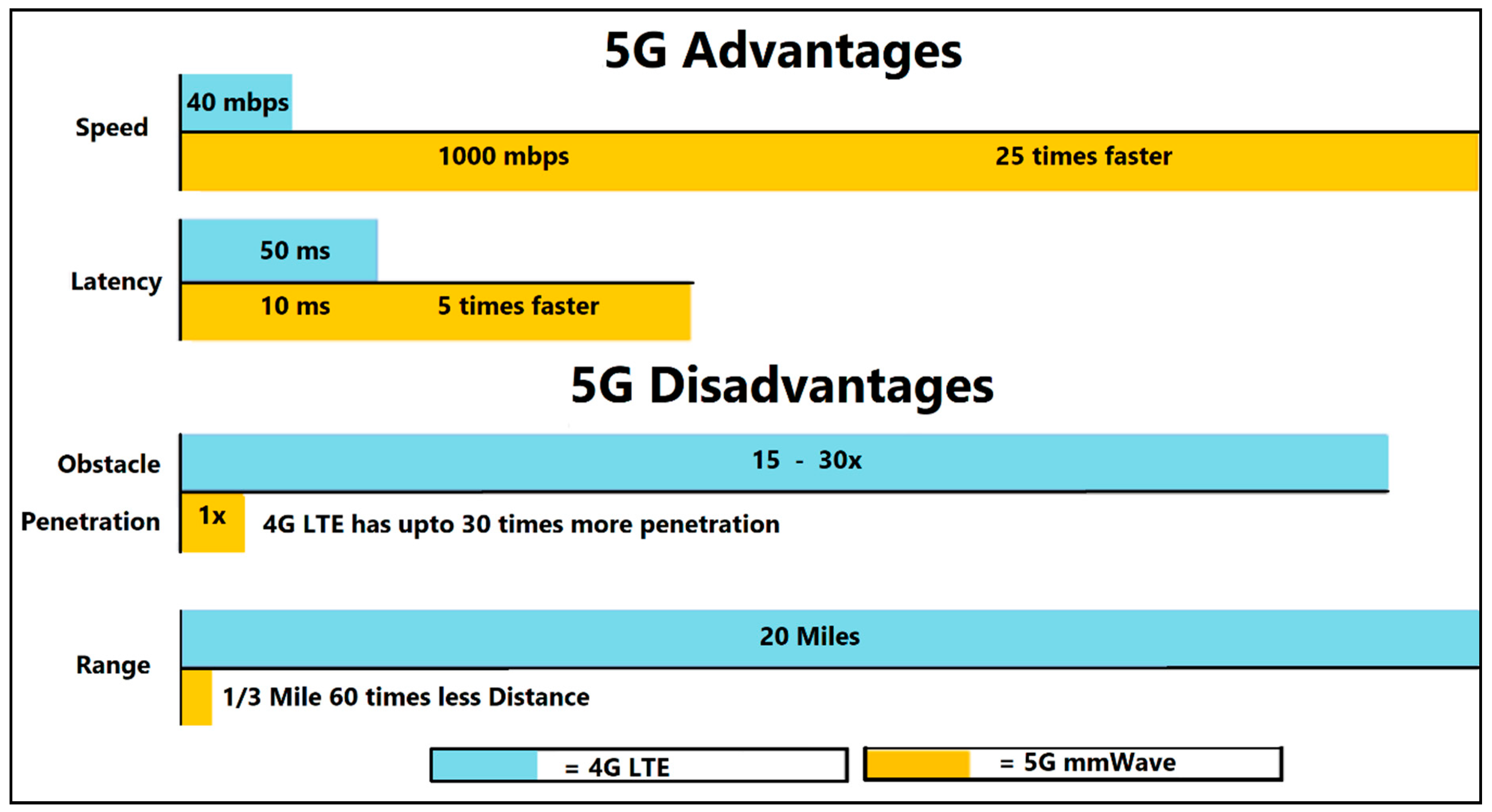
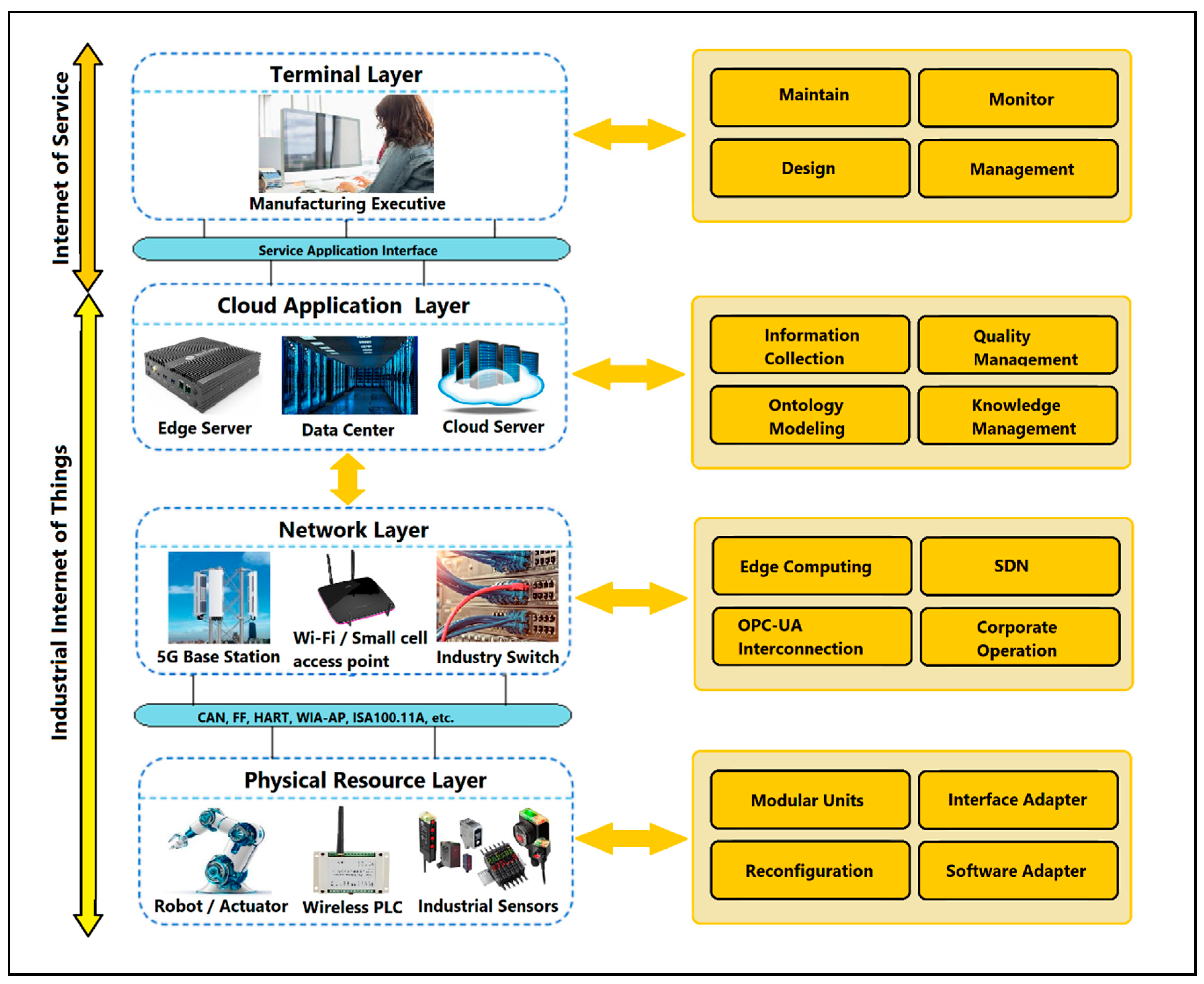
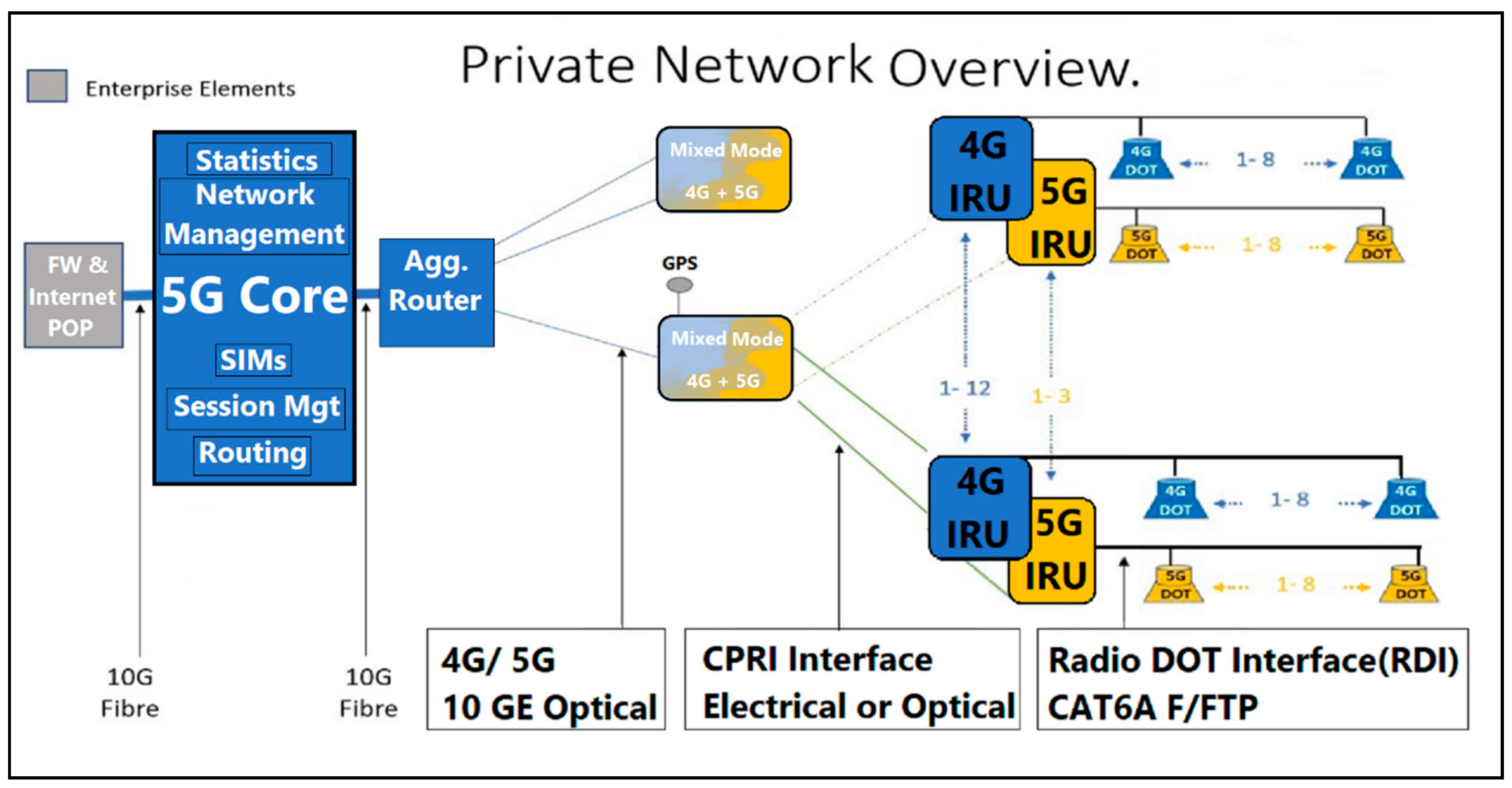
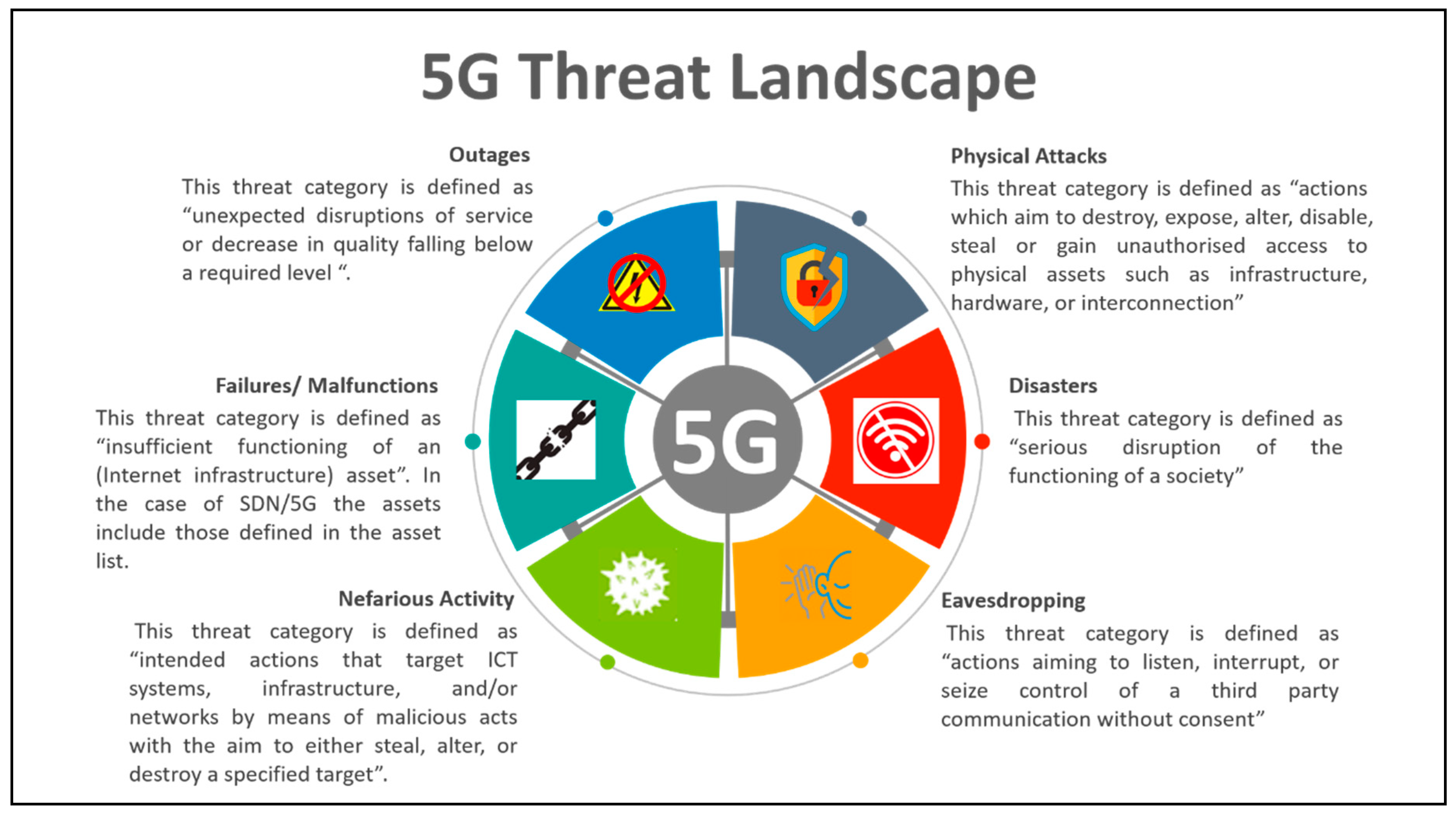
| Network Type | Average Download Speeds | Peak Download Speeds | Theoretical Download Speeds |
|---|---|---|---|
| 3G | 8 Mbps | ~20 Mbps | 42 Mbps |
| 4G | 32.5 Mbps | 90+ Mbps | 300 Mbps |
| 5G | 130Mbps–240 Mbps | 599 Mbps+ | 10–50 Gbps |
| Network Type | Milliseconds (ms) |
|---|---|
| 3G Network | 60 ms (Typical) |
| 4G Network | 50 ms (Typical) |
| 5G Network | 1 ms (theoretical) |
| Use-Case Category | Scenario | Impact |
|---|---|---|
| Time-critical processes |
| Increased efficiency and yields; safety |
| Non real-time processes inside the factory |
| Optimized management of production facilities |
| Enterprise communication |
| Improved business operations |
| Deployment Scenarios and Resource Management | How to identify where the best locations to install the MEC platforms physically and how to manage them remotely. |
| Computational Caching and Offload | The combination of computing and storage locally can provide an increase in compute capability and speed to the user, whilst reducing traffic to the cloud connections. There are challenges here around deciding what to cache, as each user’s computing requirements may have unique data requirements. |
| IoT Applications and Big Data Analytics | MEC can help reduce and refine datasets before sending back to big data platforms for analysis/deep learning. |
| Mobility Management | Ensuring continuous connectivity for mobile users is a crucial consideration for MEC, with trajectory predictions (of the user) enabling the caching of data amongst MEC nodes in the network. |
| Security and Privacy | As there are multiple compute points, at remote locations, the attack surface is increased exponentially over a traditional cloud platform. Privacy of the user’s computing requirements is also a key concern for MEC systems. |
| Protocol | Frequency | Wavelength | Range |
|---|---|---|---|
| Wi-Fi (2.4G) | 2401 MHz–2483 MHz | 12 cm | 150 m |
| Wi-Fi (5G) | 5150 MHz–5875 MHz | 5 cm | 120 m |
| Bluetooth | 2400 MHz–2485 MHz | 12 cm | 10–100 m |
| LoRA | 868 MHz | 35 cm | 10 km+ |
| 3G | 900/2100 MHz | 33.3/14 cm | 100 m to >5 km |
| 4G (LTE) | 800/1800 MHz | 37.5/17 cm | 100 m to >5 km |
| 5G | 700 MHz/3.6 GHz/26 GHz | 43 cm/8 cm/1 mm | 50 m to >5 km |
© 2020 by the authors. Licensee MDPI, Basel, Switzerland. This article is an open access article distributed under the terms and conditions of the Creative Commons Attribution (CC BY) license (http://creativecommons.org/licenses/by/4.0/).
Share and Cite
O’Connell, E.; Moore, D.; Newe, T. Challenges Associated with Implementing 5G in Manufacturing. Telecom 2020, 1, 48-67. https://doi.org/10.3390/telecom1010005
O’Connell E, Moore D, Newe T. Challenges Associated with Implementing 5G in Manufacturing. Telecom. 2020; 1(1):48-67. https://doi.org/10.3390/telecom1010005
Chicago/Turabian StyleO’Connell, Eoin, Denis Moore, and Thomas Newe. 2020. "Challenges Associated with Implementing 5G in Manufacturing" Telecom 1, no. 1: 48-67. https://doi.org/10.3390/telecom1010005
APA StyleO’Connell, E., Moore, D., & Newe, T. (2020). Challenges Associated with Implementing 5G in Manufacturing. Telecom, 1(1), 48-67. https://doi.org/10.3390/telecom1010005






